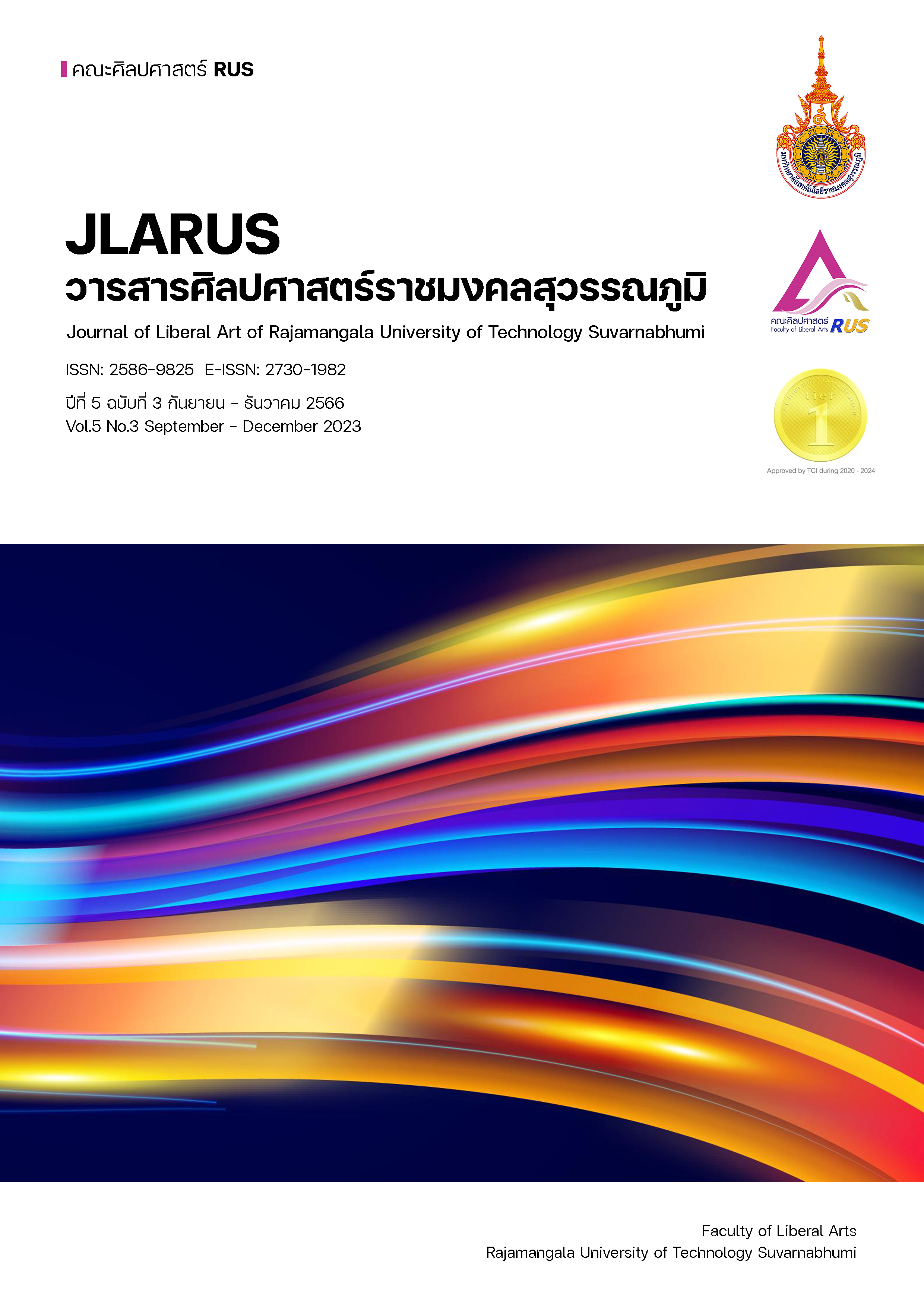DRAFTING THE CURRICULUM TO ENHANCE THE MATHEMATICAL LITERACY FOR GRADE 9 STUDENTS
Main Article Content
Abstract
This was a research and development paper aimed to study the components and indicators of the mathematical literacy for Grade 9 students and draft the curriculum to enhance the mathematical literacy for Grade 9 students. The experimental group in this study was 38 students in Grade 9, Srinakharinwirot University Prasarnmit Demonstration School (Secondary) in the first semester of the 2023 academic year. The research instruments consisted of four parts which were 1) the assessment form to check for the appropriateness of the components, sub-components, and indicators of the mathematical literacy for Grade 9 students and the congruence of the components, sub-components, and indicators of the mathematical literacy for Grade 9 students, 2) a mathematical literacy test to evaluate the mathematical literacy of Grade 9 students, 3) drafting the curriculum to enhance the mathematical literacy for Grade 9 students, and 4) the assessment form to check for the appropriateness and congruence between the elements of the draft curriculum to enhance the mathematical literacy for Grade 9 students. Statistics used in the data analysis were percentage, mean, standard deviation, and Cronbach’s alpha coefficient. From the results of this study, it was found that the components, sub-components, and indicators for Grade 9 students' mathematics literacy consisted of two main components, 11 sub-components, and 27 indicators. Moreover, each element in the draft curriculum to enhance the mathematical literacy for Grade 9 students was most appropriate. The mean was 4.62 and the standard deviation was 0.52, and each element in the draft curriculum to enhance the mathematical literacy for Grade 9 students had congruence with an overall average of 0.99.
Article Details

This work is licensed under a Creative Commons Attribution-NonCommercial-NoDerivatives 4.0 International License.
References
ชรินรัตน์ ด้วงธรรม และ วนินทร พูนไพบูลย์พิพัฒน์. (2565). การพัฒนาความฉลาดรู้ด้านคณิตศาสตร์ด้วยการจัดการเรียนรู้ออนไลน์ ตามกระบวนการคิดให้เป็นคณิตศาสตร์เรื่อง ความน่าจะเป็น ของนักเรียนชั้นมัธยมศึกษาปีที่ 5. Journal of Roi Kaensarn Academi, 7(11), 372-389.
ทีฆทัศน์ ญาณะทวี, จักรกฤษ กลิ่นเอี่ยม และวนินทร สุภาพ. (2564). ผลการจัดกิจกรรมการเรียนรู้ตามแนว Model-Eliciting Activities ที่มีต่อการรู้เรื่องคณิตศาสตร์ เรื่อง ความน่าจะเป็น ของนักเรียนชั้นมัธยมศึกษาปีที่ 3. วารสารพัฒนาการเรียนการสอน มหาวิทยาลัยรังสิต. 15(1), 103-117.
บุญชม ศรีสะอาด. (2560). หลักการวิจัยเบื้องต้น. (พิมพ์ครั้งที่ 10). กรุงเทพมหานคร: สุวิริยาสาส์น.
มะลิวรรณ งามยิ่ง. (2563). การพัฒนาหลักสูตรความฉลาดรู้ด้านคณิตศาสตร์สำหรับนักเรียนระดับประถมศึกษา (ปริญญานิพนธ์). กรุงเทพฯ: มหาวิทยาลัยศรีนครินทรวิโรฒ.
ศิริชัย กาญจนวาสี. (2544). ทฤษฎีการประเมิน. กรุงเทพมหานคร: จุฬาลงกรณ์มหาวิทยาลัย.
ศูนย์บริการวิชาการแห่งจุฬาลงกรณ์มหาวิทยาลัย. (2564). โครงการการพัฒนาระบบสถิติข้อมูลและตัวชี้วัดเพื่อใช้ในการบริหารราชการแผ่นดินตามยุทธศาสตร์ชาติ. รายงานฉบับสมบูรณ์. กรุงเทพมหานคร: จุฬาลงกรณ์มหาวิทยาลัย.
สถาบันส่งเสริมการสอนวิทยาศาสตร์และเทคโนโลยี. (2563). PISA 2021 กับการประเมินความฉลาดรู้ด้านคณิตศาสตร์. สืบค้น 11 มีนาคม 2565. จาก https://pisathailand.ipst.ac.th/issue-2020-53/.
สิทธิพล อาจอินทร์. (2563). การพัฒนาหลักสูตร. (พิมพ์ครั้งที่ 5). ขอนแก่น: มหาวิทยาลัยขอนแก่น.
สุนีย์ คล้ายนิล. (2558). การศึกษาคณิตศาสตร์ในระดับโรงเรียนไทย การพัฒนา-ผลกระทบ-ภาวะถดถอยในปัจจุบัน. กรุงเทพมหานคร: ซัคเซสพับลิเคชั่น.
อภิชญาดา บุญวิรัตน์ และ ปริญญภาษ สีทอง. (2565). การพัฒนาหลักสูตรเสริมทักษะการแก้โจทย์ปัญหาทางคณิตศาสตร์โดยใช้แนวคิดกระบวนการแก้ปัญหาแดปิค สำหรับนักเรียนชั้นประถมศึกษาปีที่ 6. วารสารมนุษยศาสตร์และสังคมศาสตร์ มหาวิทยาลัยราชพฤกษ์. 8(2), 465-480.
เอกวิทย์ ณ ถลาง. (2551). ข้อคิดเรื่องหลักสูตร: คู่มือนิเทศการศึกษา. กรุงเทพมหานคร: มหาวิทยาลัยราชภัฎสวนสุนันทา.
Eisner, E.W. (2017). The Enlightened Eye: Qualitative Inquiry and the Enhancement of Educational Practice. New York: Teachers College Press.
Firdaus, M. F., Wahyudin, W. & Tatang, H. (2017). Improving primary students’ mathematical literacy through problem based learning and direct instruction. Academic Journals Educational Research and Reviews. 12(4), 212-219.
Hafizh N. & Bambang A. P. (2017). Improving ability mathematic literacy, self-efficacy and reducing mathematical anxiety with learning Treffinger model at senior high school students. International Conference on Science and Applied Science. 2(1), 130-138.
Rizki, L. M. & Priatna, N. (2018). Mathematical literacy as the 21st century skill. Journal of Physics Conference Series. 1157(4), 1-5.
Tyler, R. W. (1964). Basic Principles of Curriculum and Instruction. Chicago: University of Chicago Press.


